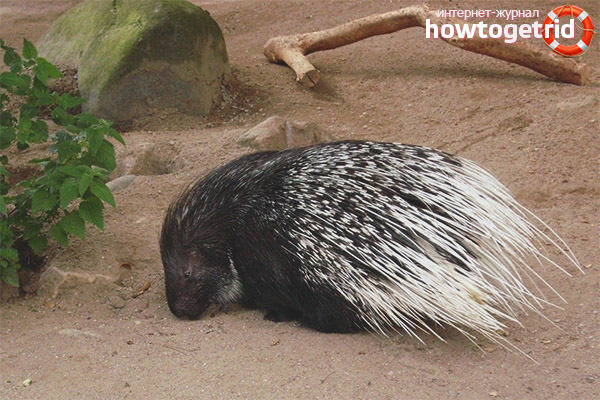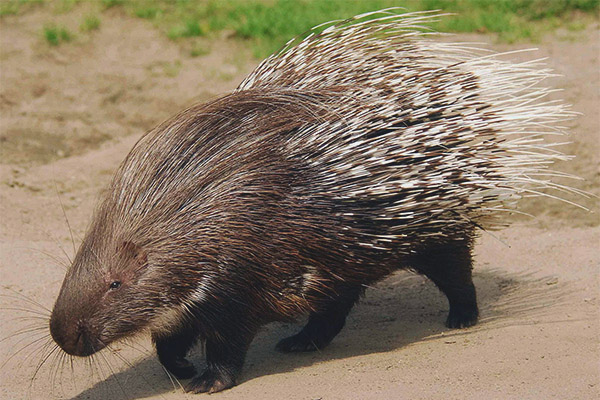The content of the article
Porcupine managed to become famous for its unusual appearance far beyond the limits of its natural habitat. It belongs to rodents and is a mammal. There are a total of 8 subgenera porcupines, classified by their habitat. How did it happen that during the years of evolution this animal acquired such massive needles?
Porcupine species and classification
There are several species of porcupines, and each of them is different from each other:
- Malayan porcupine. This is a rather large rodent, the body length of which in adulthood is 70 cm, and the tail is 11 cm. The color of its needles can have all shades of yellow, diluted with white spots. They live in Nepal and Northeast India.
- South African porcupine. This species also has large body sizes, reaching up to 80 cm. It has a main row of needles 50 cm long and a defensive row, the length of needles in which reaches 25 cm. This species likes to settle in the foothills without climbing above 2000 m above sea level .
- Comb crested porcupine. This species is best studied by man. The body is long and heavy, weighs an adult 27-30 kg. They live throughout the Middle East, and are also found in India and Sri Lanka.
- Indian porcupine. Representatives of this species, as the name implies, are settled in the territory of India. They also live in the South of Asia. Females of this species give birth 2 times a year, bringing from 1 to 4 cubs. Compared with other species of porcupines, this is an average indicator.
Appearance and needles
The appearance of a porcupine is so unique that this animal cannot be confused with any other in the world. And all thanks to the huge light needles, covering most of the back porcupine. They are quite massive and can reach a length of 50 cm with a thickness of a little less than a centimeter. They are a natural part of the animal cover, which includes several more elements:
- Needles of different lengths, transformed during the years of development of the species from rigid long hairs.
- Wool with increased elasticity.
- Flat needles, the tip of which is hidden under a layer of fur and other needles.
- Soft fur.
Because of its weight and ability to cling with a point to everything, the porcupine quills do not hold well in the skin of the back and often fall out. However, this does not cause the animal any pain and discomfort, and in the place of fallen out new needles will soon grow. In order to protect itself, an animal can leave a whole sheaf of needles in the face of a predator, which has a very painful effect. There are cases when dogs find a porcupine during a walk and try to play with it, and a few minutes later the owners take the pet to the veterinary clinic.
There is a popular misconception that a porcupine can shoot needles at an enemy. It is not true. As already mentioned, the porcupine does not have to part with a few dozen needles, and the attacker, as a rule, cannot predict that a rodent will give him his spiny back at the last moment.
Another myth associated with the needles of a porcupine, says that their tips allegedly contain poison, which leads to a long and painful death. And this misconception is not confirmed.Porcupine needles do have a poisonous effect on the body, but this is not connected with poison, but with an incredible number of microbes living on the porcupine quills. Hardly ever the water touched the back of the animal. It is therefore not surprising that each needle becomes a breeding ground for infection and leads to blood infection.
Inside the needle is either hollow or filled with a special substance - it all depends on their location. When attacked by a predator, the porcupine tries to frighten the enemy by raising needles up and making a sound similar to the ringing and clicking of a rattle. In case this does not help, the porcupine will not run away from the battlefield, but will bring the needles into action.
Short hair covers the belly, muzzle and paw of a porcupine. The tail is also covered with wool, but it is harder at this place than on the rest of the body, and with it small needles in the shape of an inverted glass grow on it. The intensity of color varies throughout the body, moving from brown to black. Along the sides are alternating stripes of dark and light color.
The body of the porcupine has a length of from 40 to 80 cm with a weight range of 3 to 30 kg. In this case, an important role is played by the eating habits of an individual individual, because a dense diet allows the animal to gain several kilograms above the normal mass.
Porcupine movement is slow and very clumsy. All because of their short legs, which do not allow him to develop great speed. The paws of the porcupine are covered with thin brown hairs through which you can see the skin. The number of fingers on the front limbs ranges from 3 to 4, the hind legs are five-fingered, and the first finger is not fully developed. Each finger has a tenacious black claw at the end. The porcupine's tail reaches a length of 14 cm, but in some subspecies it grows to 20-25 cm.
Porcupine has rather massive bones of the facial section, the skull itself is elongated, with a dull short muzzle. Some species have an ornament in the form of a bristly comb in the middle of the crown. The porcupine has a strong fit of the front teeth that grow all their life, which excludes their complete grinding. In total, this animal has 20 teeth, and 4 of the front are noticeably larger and darker than the rest.
The ears and eyes of the porcupine are disproportionately small and are located near the forehead. The shape of the ears resemble human, and the nose occupies most of the muzzle. Porcupines rarely make any sounds, but in the event of a threat, they can puff, grunt, and even grunt.Such sounds mean that the animal is preparing to attack.
Lifestyle in nature

The porcupine settles in the foothills and in various wastelands. He will be nice in the rocky terrain and deserts. Among the rocks and caves in the porcupine there is an opportunity to make a lair of the already existing natural crevices. Otherwise, the animal will dig a hole on its own. The length of the porcupine burrow exceeds 10 meters and goes under the ground up to 4 m. The bur has several branches, in one of which there is a sleeping place, covered with dried grass and leaves of small bushes.
The peak of porcupine activity falls at night, the beast spends its day in the hole. With the onset of cold weather, the animal's activity slows down, but the porcupine does not fall into full hibernation. The rodent is not particularly afraid of the person and settles near the dwelling, which makes it possible to observe the porcupine in its natural habitat.
Nutrition
At night, the animal is able to overcome several kilometers in order to find a small supply of food. During such trips, they leave well-distinguishable trails along which it is easy to find a porcupine's den. Plant food is the main food of this rodent.The porcupine eats young shoots, herbaceous plants, roots, flower bulbs and tubers. With the onset of autumn, he moves to a more diverse food - vegetables, melons and grapes. In the winter season, the porcupine can gnaw the bark of trees. This is caused by a lack of vitamins and protein, which cause the animal to eat something inedible.
Sometimes small insects fall into the porcupine diet. He eats them to eliminate the lack of sodium in the body. This is the only case when the porcupine is distracted from its vegetarian diet. Despite the presence of large front teeth, it is not able to chew hard fibers or break the chitinous shell of beetles.
Breeding
Porcupine breeding season begins in March. The female carries cubs for 3-4 months, after which it gives birth to 2-3, sometimes - 5 cubs. Already in the first days of life, newborns have small needles that grow over time and grow stronger. But for now they are pressed to the back and are just starting to harden. However, after a week they become sharp enough to prick.Usually, the female feeds her cubs with milk for no longer than 2 weeks, after which they begin to eat plant food following the example of the parent.
Under natural conditions, the porcupine is unlikely to live longer than 9–10 years, but under conditions of zoos, this figure increases to 20–22 years.
Impact on the ecosystem

By its existence, porcupines significantly disturbed the ecosystem and brought out from a number of predators those traits that were before the meeting with the rodent are not typical of them. One such example is the appearance of tigers and leopards hunting people for food in India and Africa. There are cases when one big cat killed 100 or more people in several years, coming to the same village. This happened and is due to the fact that a predator, having run into the needles of a porcupine, can no longer get rid of them on its own, no matter what attempts it takes. The infection that ensued after this painful incident weakens the already vulnerable animal, as a result the big cat becomes an invalid and clings to every new place where it manages to find food.
Human interaction
Porcupines do not stop fences and durable iron mesh. It costs nothing to dig a tunnel under the fence, and to cut the grid through with its powerful incisors. In the past, such actions of these animals gave a lot of headache to planters, and regular hunting was carried out on porcupines. Now their population has decreased significantly, and the damage caused is no longer so significant.
Interesting Facts about Porcupines
- African porcupines have an unusual entertainment, described by J. Durrell. He claimed that the porcupines in the area where he was staying, rolled down from smooth stone elevations, and then climbed back. He made this assumption based on the traces they left behind.In consequence, it was confirmed that these rodents really arrange such games.
- In African countries, roast porcupines are served as a delicacy.
- Due to its sedentary lifestyle, porcupines with no particular stress endure life in zoos and with good care they multiply quickly.
Video: Porcupine (Hystrix cristata)











To send